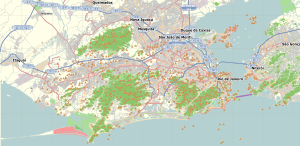Vila Isabel | |
|---|---|
Neighborhood | |
 | |
| Coordinates: 22°54′56″S 43°14′55″W / 22.91556°S 43.24861°W | |
| Country | |
| State | Rio de Janeiro (RJ) |
| Municipality/City | Rio de Janeiro |
| Zone | North Zone |
| Population (2010)[1] | |
| • Total | 86,018 |
Vila Isabel is a middle-class neighborhood in the North Zone of Rio de Janeiro, Brazil. Known for being one of the cradles of samba in Brazil, it is located in the subprefecture of Grande Tijuca (pt), its music-themed Boulevard 28 de Setembro (pt) celebrates the neighborhood's long musical heritage. The neighborhood was named in honor of Brazilian Princess Isabel, renowned for abolishing slavery in Brazil. It is home to Unidos de Vila Isabel, one of the most traditional samba schools in Rio de Janeiro.
History


The neighbourhood arose from the entrepreneurial spirit of João Batista Viana Drummond (pt), the future Baron of Drummond, a progressive businessman and real estate developer. In 1872 he acquired the lands of the Imperial Quinta do Macaco, owned by Empress Amélia, when, following the enactment of the Law of Free Birth in 1871, the estate's slaves were freed.̺[2]
An abolitionist and friend of prominent figures who shared his political ideals, Drummond gave the streets and squares of the development names and dates alluding to the cause. The very name of the neighbourhood was a tribute to Princess Isabel[3] and its main thoroughfare, Boulevard 28 de Setembro, is a tribute to the date on which the Law of Free Birth was sanctioned.[2]
The district was officially founded on 3 January 1872, inspired by Parisian urbanism. To urbanise and subdivide it, Drummond organised the Companhia Arquitetônica de Vila Isabel (pt) (Vila Isabel Architectural Company) in 1873, hiring architect Francisco Joaquim Béthencourt da Silva, a disciple of Grandjean de Montigny.[2]
The former estate was crossed by two old roads, Macaco and Cabuçu, which became Boulevard 28 de Setembro and Rua Barão do Bom Retiro respectively.
The transport system - horsel-drawn trams - would be provided by the Companhia Ferro-Carril de Vila Isabel, an enterprise also set up by Drummond. It was inaugurated in 1875, linking the neighbourhood to the centre of Rio.[2] The neighbourhood hosted the first Rio de Janeiro Zoological Garden that opened in July 1888, and which was the birth place of the popular illegal gambling game, the jogo do bicho.[3][4] (The Vila Isabel zoo closed its doors in the 1940s. It was relocated to Quinta da Boa Vista, in March 1945.[5])
The neighbourhood was once home to the Fábrica de Tecidos Confiança (pt), a textile factory located in Aldeia Campista, between Vila Isabel and Andaraí, constructed there in 1885 along with workers' housing that accomondated over a thousand residents pulled workers into the neighborhood and the construction of working-class housing.[2] The former factory is now a supermarket. By the 1890s, this swathe of former farmland west of Rio’s historic center had become the fastest growing part of the city.[3]
In the 1920s, the neighbourhood became a meeting place for samba musicians and bohemians, such as Noel Rosa, Braguinha, Orestes Barbosa (pt), Almirante (pt), Henrique Brito and the famous Bando de Tangarás (pt) and acquired a reputation as a bohemian neighbourhood. Noel Rosa has a statue of him seated at a cafe table on the Boulevard 28 de Setembro.
In 1964, on the Fourth Centenary of Rio de Janeiro, architect Orlando Madalena presented a project to resurface the pavement of the Boulevard 28 de Setembro in black and white Portuguese cobble stones, from Largo do Maracanã to Praça Barão de Drummond, and decorate them with musical notes from Brazilian popular music, the names of their authors and musical instruments. Today these pavements are known as "Calçadas Musicais de Vila Isabel".[2]
References
- ^ "Bairros Cariocas" (in Portuguese). Retrieved 2021-05-27.
- ^ a b c d e f Bogéa;Pires;Mello 2019.
- ^ a b c Chazkel 2011, pp. 29-31.
- ^ Andrade 2009.
- ^ "Mais antigo do Brasil, Zoo do Rio recebe multidões na inauguração em 1945". O Globo - Acervo (in Portuguese). 14 May 2015. Retrieved 27 December 2023.
Sources
- Andrade, Maria do Carmo (2009). "Jogo do Bicho". Pesquisa Escolar On-Line. Joaquim Nabuco Foundation. Retrieved 25 December 2023.
- Bogéa, Henrique; Pires, Marina; Mello, Natasha (2019). Vila Isabel: história e urbanismo na zona norte (Thesis) (in Portuguese). Niteroi RJ: Universidade Federal Fluminense, Escola de Arquitetura e Urbanismo.
- Chazkel, Amy (2011). Laws of Chance: Brazil's Clandestine Lottery and the Making of Urban Public Life. Durham NC/London: Duke University Press. ISBN 978-0-8223-4973-0.


